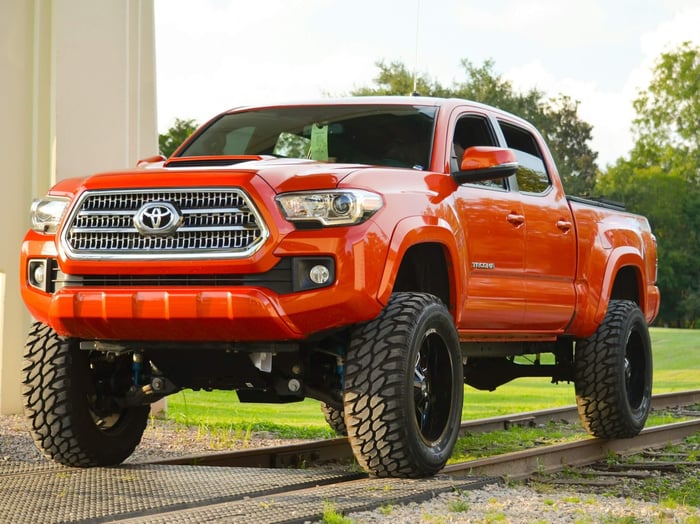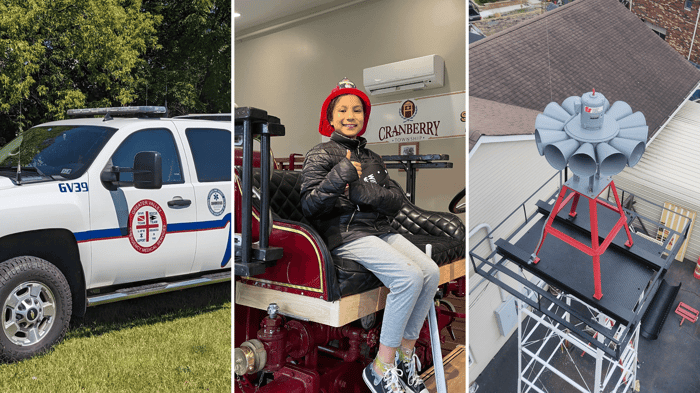If you're in the automotive market to buy or sell, you’re probably asking, “Why are trucks so expensive?” That’s a fair question. Pickup trucks today are significantly more expensive than in the past, with certain newer models exceeding $100,000! This surge in price has prompted many to speculate why these vehicles now command such high values.
People point to inflation, a high consumer demand, and modern day technology. Turns out, there’s more than a few reasons why trucks are so expensive.
8 Reasons Modern Trucks Are So Expensive
1. Increased size and complexity
Modern pickup trucks are bigger and heavier than their predecessors, requiring more materials and sophisticated engineering. Compared to trucks from only 20 years ago, the difference in size is noticeable. With the F-150 as a reference, the 2003 model has a cab that is about 6 inches shorter in height and 23 inches shorter in width than the 2023 version.
Compared to models from 40 years ago, the change is much more evident. The 1983 F-150 was a significantly smaller truck. Back then, cabs were smaller and beds were longer. However, pickup trucks which used to be considered “workhorses,” have with time turned into “lifestyle vehicles.” That’s why cabs are now longer than the beds.
F-150 Model Year / Curb Weight
| F-150 Model Year | Curb Weight |
| 2023 | 4,000 - 5,800 lbs |
| 2003 | 3,935 - 4,800 lbs |
| 1983 | 3,400 lbs |
2. Material quality
Pickup trucks are built to handle tough work, so they feature durable materials like high-strength steel and sturdy suspensions. These heavy-duty materials are naturally more expensive than their less sustainable counterparts.
The materials used today have undergone a significant transformation over the past 40 years, driven by advancements in technology, changing priorities, and market demands. Let’s look at a breakdown of those key differences.
Pickup Tricks in the 1980s:
- Frame: Primarily used ladder frames made of heavy-duty steel like box-section or C-channel profiles. These offered rigidity and strength for hauling and off-road use.
- Body: Mostly employed single-wall sheet metal, often steel, for the bed and body panels. This kept costs down, but made the trucks susceptible to rust and dents.
- Interior: Interiors were utilitarian, featuring vinyl or cloth upholstery, rubber floor mats, and minimal soundproofing. Plastic trim dominated, with metal accents for durability.
- Engine: Large displacement V8 engines were common, offering ample power for towing and hauling, but compromising on fuel efficiency. Cast iron was the primary material for engine blocks and heads.
Pickup Trucks Today (2023):
- Frame: While ladder frames remain prevalent, high-strength steels and even aluminum are increasingly used to reduce weight and improve fuel efficiency. Some manufacturers explore alternative materials like carbon fiber for specific models.
- Body: Double-wall construction with a layer of composite or soundproofing material sandwiched between the outer and inner metal panels is now common. This improves noise insulation, dent resistance, and overall rigidity.
- Interior: Interiors have become more refined, featuring cloth or leather upholstery, along with soft-touch materials on dashboards and door panels. Technology integration with touchscreens and driver-assistance features are standard on many models.
- Engine: Smaller displacement V6 engines with turbochargers are increasingly favored for their balance of power and fuel efficiency. Aluminum is commonly used for engine blocks and heads to further reduce weight. Some manufacturers offer hybrid and electric powertrains for improved fuel economy and emissions reduction.
Additional Materials:
- Plastics: High-strength and lightweight plastics are now widely used for various components like bumpers, grilles, and interior trim. This helps reduce weight and corrosion.
- Composites: Advanced composites like fiberglass and carbon fiber are finding their way into certain truck beds and body panels for weight reduction and increased strength.
Key Takeaways:
- Modern pickup trucks use lighter and more advanced materials like high-strength steels, aluminum, and composites to improve fuel efficiency, performance, and durability.
- Interior materials have shifted towards comfort and refinement with the use of soft-touch plastics, leather upholstery, and advanced technology integration.
- Engine materials have evolved to favor smaller, more efficient units with the use of aluminum and turbocharging technology.
- The evolution of pickup trucks reflects the changing priorities of both manufacturers and consumers.
3. Supply and demand
As of today, pickup trucks remain a popular choice for both work and personal use. Demand has been high since post-pandemic, the explosion of remote work, and the housing market boomed. More people bought homes, stayed inside, and performed DIY projects. They also bought more RVs as they couldn’t travel outside the country. In response, they bought more vehicles like pickup trucks.
Ongoing supply chain disruptions and material shortages have allowed manufacturers to set higher prices knowing there will still be buyers.
People continue to rely on these vehicles for recreational activities like gardening, boating, and snow activities. After a drop to 237 million visitors in 2020, national parks are back to receiving over 300 million visitors annually! The reason for all of this is pickup trucks ensure an easier time traveling, especially off-road, transporting many items at once, and doing so safely in a rugged vehicle.
4. Profit margins
Pickup trucks are generally profitable for manufacturers, especially companies like General Motors, who are more inclined to keep profit margins high even in a competitive market.
5. Luxury creep
Increasingly, pickup trucks are blending workhorse capabilities with luxury features. The tech game for today’s pickup trucks has gone into overdrive. Features now include touchscreen infotainment systems, driver-assistance technologies, and even off-road performance enhancements - which was already a highlight. Nowadays, a modern family car comes with increased accessibility for outdoor recreation with four-wheel drive. Not to forget the leather interior, panoramic sunroof, and high-end sound system, but these fanciful features also inflate the price tag.
The specific functionalities and options will vary depending on the make, model, and trim level, but below are some of the available choices.
Enhanced Safety and Driving Assistance:
- Automatic Emergency Braking (AEB): Senses impending collisions and brakes automatically to avoid or minimize the impact.
- Lane Departure Warning and Lane Keep Assist: Signals an alert if you drift out of your lane and gently steers you back on track.
- Adaptive Cruise Control: Maintains a safe distance from the car ahead, adjusting speed automatically in stop-and-go traffic.
- Surround View Camera System: Provides a bird's-eye view of your truck and surroundings, adding ease to parking and navigating tight spaces.
- Blind Spot Monitoring with Trailer Coverage: Tracks your blind areas even when towing a trailer.
- Trail Turn Assist: Aids in tight maneuvering on rough terrain.
Connectivity and Entertainment:
- Large Touchscreen Infotainment Systems: Contains Apple CarPlay and Android Auto integration, navigation, music streaming, and more, all at your fingertips.
- Wi-Fi Hotspots: Turns your truck into a mobile internet hub for all of your devices.
- Premium Audio Systems: Provides high-quality speakers and immersive surround sound.
- Head-Up Displays: Projects important information like speed and navigation directions onto the windshield for a distraction-free view.
- Remote Start and Lock/Unlock: Enables truck access from your phone, including temperature control and door locks.
Performance and Efficiency Enhancements:
- Advanced Engine Technologies: Includes turbochargers and hybrid options for more power and better fuel economy.
- Adaptive Suspension Systems: Automatically adjusts to road conditions for a smoother ride.
- Towing Technology: Makes hauling a breeze with integrated trailer brake controllers and trailer sway control.
- Cargo Management Systems: Includes built-in organizers, bed extenders, and tailgate speakers to turn your truck bed into a multifunctional workspace.
Comfort and Convenience Features:
- Heated and Cooled Seats: Ensures sitting is comfortable regardless of the weather.
- Panoramic Sunroofs: Lets the sunshine in for an open-air feel.
- Massaging Seats: Melts away the stress of a long drive.
- Remote Keyless Entry and Push-Button Start: Provides a more modern and convenient way to access your truck.
6. Inflation and material costs
As continued inflation slows home buying, DIY projects, and boat sales, the same is happening to pickup trucks. Prices are high and those seeking personal use trucks are going to think twice before buying either new or used. Likewise, buyers in the market for fleet vehicles will be budgeting their spending for the near future.
As a point of comparison highlighting the increased cost, take a look at what buying a new Ford F-150 has looked like in recent years.
Base Model Price for New Ford F-150s
| Year | Base Model Price (USD) | Increase from Previous Year (%) |
| 2015 | $26,495 | N/A |
| 2016 | $26,895 | 1.50% |
| 2017 | $27,190 | 1.08% |
| 2018 | $28,190 | 3.72% |
| 2019 | $28,790 | 2.10% |
| 2020 | $29,150 | 1.22% |
| 2021 | $30,490 | 4.60% |
| 2022 | $31,230 | 2.43% |
| 2023 | $34,585 | 10.78% |
Based on current price tags for the F-150 and other trucks, if you finance there are generally low monthly payment options available. However, you can expect to pay a higher interest rate.
That’s why it's important to consider what type of pickup you're looking for and how you plan to use it. Base models can still be relatively affordable, but heavily loaded luxury configurations can reach six figures.
7. The Multifaceted Role of Trucks
Pickup trucks have evolved far beyond their original purpose of hauling and towing. They now serve as family sedans, business vehicles, and off-road adventurers. This versatility has led to an increase in demand for models with various features and trim levels, such as the RAM 1500, which offers over 50 configurations. The adaptability to different roles in people’s lives ensures that consumer interest will never diminish completely. Pickup trucks are too essential for the country’s infrastructure, aiding in the transportation of individuals, goods, and supporting numerous businesses.
8. Resale Value
Trucks tend to retain their value better than many other vehicles, even with higher mileage. A high resale value means that even used trucks can command premium prices. The durability and longevity of trucks also lead drivers to opt for repairs rather than waiting for new models, maintaining demand and value in the used truck market.
Some buyers make a living from acquiring, fixing up, then reselling used trucks. There’s definitely a process to keeping trucks resale ready, but wth the right strategy and a never ending demand for these vehicles, the venture can really prove to be worthwhile.
Conclusion
All in all, the high cost of trucks can be attributed to their versatility, size, supply and demand dynamics, and high resale value. There’s also the power options, advanced safety systems, technological advancements, and the inclusion of various luxury features. These factors combine to make trucks one of the most expensive vehicle categories on the market today.
Check out Municibid today and find yourself a used truck for personal use or to add to your work fleet!



